
RPM Tutorials
Using the RPM Software
The Rotman Portfolio Manager application is organized in a modular way so that each user can personalize the look and feel of their trading interface. Each support module contains different information pertaining to trading and your portfolio. To open a module, simply click on the button at the top of the toolbar. The module can then be moved and resized anywhere on the screen.
Account Module
The first module that you should open is the “Accounts” module. It gives you a quick overview of your account information and currency balances. Since RPM is designed to be international in scope, the majority of accounts will have multiple sub–accounts that show balances of each currency that you are entitled to trade securities with. In order to keep track of your portfolio value, RPM converts all of your holdings and balances to a single base currency which is reported at the top as your Portfolio Value.

Currencies:
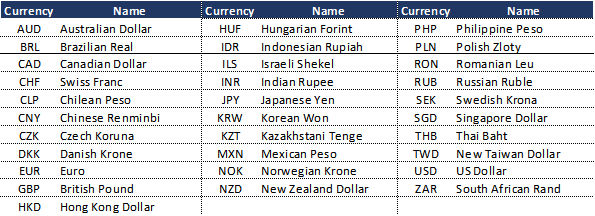
If your account is a margin account, RPM allows for short cash positions. This means that you can decide how to fund a trade (for more information on this, please refer to the “Funding your Trade” section). RPM also pays and charges interest on a daily basis based on your ending daily cash balance at the rates input by your professor. These rates are displayed as annualized rates in the “Class Details” window that can be found once you click your name on the top–left corner.
Market Watch Module
The Market Watch allows you to monitor quotes for different securities. It provides at least 15–minute delayed quotes for the securities available to be traded in RPM.
To watch a particular security, simply type in the corresponding ticker in the appropriate format (the format varies for different types of investment instruments – see further below) in the Symbol box and click on Submit.
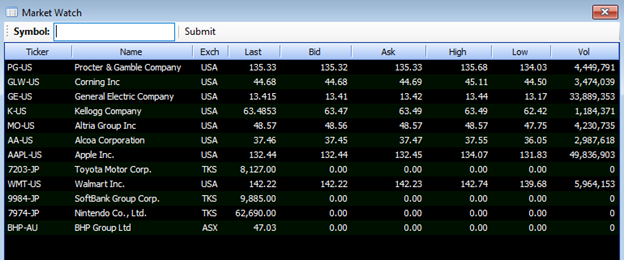
Tip: You can double click on any security from the Market Watch to open a New Trade window to trade that security.
Ticker symbols require “–[country code]” at the end of the ticker. For example, for Microsoft, the ticker will be MSFT–US. Canadian stocks are input using their ticker symbol with the “–CA” extension (e.g. Royal Bank would be RY–CA).
You can find the correct ticker symbol of any security that you are interested in by using the “Ticker Search” module. This function allows you to search the ticker symbols by name, exchange, and many other specifications. For country codes, you may refer to the “Equities Symbology” tab in the Ticker Search window.
For other security types (Bonds, Options, and Futures) please refer to the other tabs in the Ticker Search window.
Portfolio Watch Module
“Portfolio Watch” (found under the Portfolio menu) is the module where you can monitor your portfolio holdings. It displays all of your current holdings and details about each holding.
For each security that is currently in your portfolio, it shows your Position, VWAP, Cost, Market Quote, Market Value, P/L, Currency, and Vehicle Type.
Position – The amount of securities either owned (which constitutes a long position) or borrowed (which constitutes a short position) in that holding.
VWAP – Volume Weighted Average Price, which represents the average price of that holding.
Cost – The historical price that you have paid for that holding, which also equals the position multiplied by the VWAP.
Mkt. Quote – The 15–minute delayed quote for the security.
Mkt. Value – The market value of that holding, which represents the approximate liquidation value of the holding at the current bid or ask price.
P/L – The unrealized Profit/Loss, which is the difference between the Market Value and the Cost of that holding.

Trades Module
New Trade
The ”New Trade” module (found under the Trades menu) allows you to submit trade orders to buy and sell securities. In the Ticker field, type in the ticker symbol of the security that you wish to trade. Then choose the order type by clicking to toggle the BUY/SELL button. In the Volume field, specify the number of the securities that you wish to buy or sell. Next, use the drop-down menu to select your order type. There are four available choices: MKT (Market Order), LMT (Limit Order), STOP (Stop Order), and MOC (Market-on-Close). Notice that if you are making a LMT or STOP order, then you will have to specify the price in the Price field.
Once you click on the Submit button, an Order Confirmation box will appear. This box contains all the relevant information regarding the current trade. Please confirm that you have entered all the information correctly before clicking on the Submit button to confirm the trade.
As mentioned above, you can also open the New Trade module by double-clicking a security in the Market Watch.

Note: to short sell securities, simply submit a sell order. If you own shares, it will sell the shares that you own. If you do not own share, it will simply short sell the shares.
Trade Management
The “Trade Management” module is found under the Trades menu. The “Open” tab shows all of your outstanding orders with relevant details for each order. Since these orders are not transacted yet, you have the option to cancel them by clicking on the corresponding “Cancel” button under the Cancel column.
You can also set a One-Cancels-Other (OCO) name for an order. If you tag multiple orders with the same OCO name, then as soon as one of the orders gets executed, the other orders in the batch will be immediately cancelled.
The “Transacted” tab shows all your past transactions (excluding currency conversions) with relevant details.
The “Canceled” tab shows your cancelled orders.
All trades are executed at the real-time price. The trade confirmation will appear in your Trade Management module and Transaction Log module immediately, but the transaction price will be hidden for at least 15 minutes due to exchange data regulations.

Whitelisted Tickers
The Ticker Whitelist module (found under the Trades menu) is a restriction on your account imposed by your class administrator to limit the securities you trade to a specific list. Note that your instructor may not use this feature, in which case you’ll be able to trade securities according to the class settings (e.g. asset classes and their denominated currencies).

If you attempt to transact a trade outside of this ticker whitelist, you will encounter the following error message:
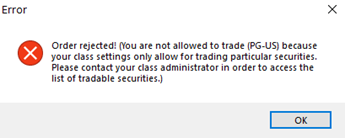
Funding your trade
RPM uses a sophisticated accounting system to allow for multiple-currency transactions in a single account. When your orders are transacted, your account will be debited by the amount of the transaction (in the case of a purchase), or credited by the amount of the transaction (in the case of a sale). If you have a margin account, you will be able to have negative currency balances, provided that you have the margin to cover the loan. If you do not want to have a negative balance of currency, simply convert currency from one of your positive balances to the currency that is negative.
For example:
The account begins with $100,000 CAD Cash.
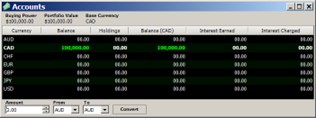
10,035.68 USD worth of stocks are purchased. Your USD balance is now negative $10,035.68 (the cost of the stock, plus the commission charge)
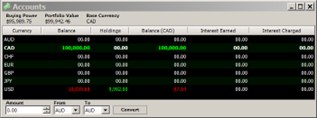
You can now either leave your balances as is, and continue to earn interest on your CAD cash and pay interest for your borrowed USD cash, or you can convert some of your Canadian currency into US dollars to cover the difference. In order to do that, use the Currency Converter at the bottom of the window. This will allow you to submit a trade to convert currency (this is also how you can trade currency).
25,000 CAD are converted into USD:
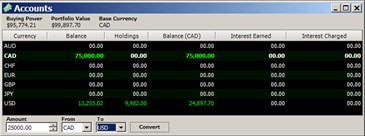
Transaction Log Module
This module shows your one-month history of trading activities. If you would like to view the entire transaction history of your account, simply click on the “Download Complete History” button on the top-right corner.
Ticker Search Module
This window allows you to search for stocks, bonds, futures, and options. Simply go to the appropriate tab, fill in the search criteria and click on Submit. Please see further details above.
Portfolio Analysis module
Found under the Portfolio menu, this analytical tool gives you a graphical illustration of your portfolio value history, asset allocation, benchmarking, and attribution analysis.
Historical Charting Module
This tool allows you to chart the historical prices for a specific security by typing the symbol of the security. Once charted, you can use the tools to zoom in/out of the chart and overlay technical analysis indicators.
Class Ranking Module
This window displays the ranking of each student in your class based on the total portfolio value. The “Historical” tab gives you a graphical illustration of the change of your ranking throughout the period as well as your average rank in the class.
Logout
Click on ‘Log Out’ to exit the application. Please note that if you leave the application unattended for 15 minutes, the server will automatically log you out. However, we suggest logging out manually to prevent unintended changes to your account.
Video Tutorial for students
How to create an account
RPM software use tutorial
Help
If you need assistance with any issues related to RPM, you can click on the “? Help” module next to Log Out to open the Interactive Help window. This allows you to submit a question to our helpdesk, and questions will be answered within 24 hours and often within minutes.

